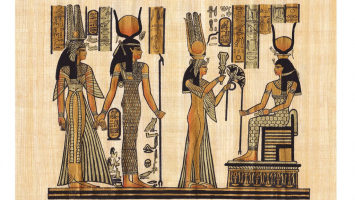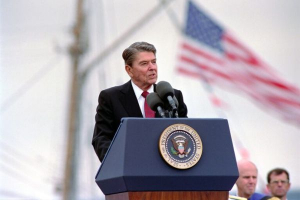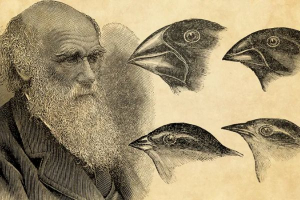Top 9 Major Accomplishments of George Washington
George Washington, an American political and military figure who lived from February 22, 1732, to December 14, 1799, is frequently referred to as the "Father ... read more...of the United States" because of his pivotal role in the founding and establishment of the nation. As a 21-year-old representing Great Britain in the French and Indian War against France, Washington initially achieved fame for his military prowess. Discover more about the major accomplishments of George Washington, including his presidency, his role as a commander in the Revolutionary War, and his domestic and foreign policies.
-
The First Continental Congress met at Carpenter's Hall in Philadelphia, Pennsylvania, from September 5 to October 26, 1774. Delegates were present to represent the colonial states, and George Washington was there to represent Virginia along with six other individuals. Addressing the colonists' complaints against the King and Parliament was one of the principal objectives of the Continental Congress. This meeting was the first real attempt to bring the colonies together to represent themselves as a group when dealing with the King because up until that time, each colony had considered itself as more or less an individual.
George Washington had fought in the French and Indian War (1754 - 1763) on behalf of Great Britain against France before the American Revolution. He had learned essential military skills during the fight, such as how to plan supplies, how to lead, how to construct forts, and how to manage subordinates. On April 19, 1775, the Battles of Lexington and Concord ignited the American Revolutionary War. The colonial revolutionaries at that time lacked an army. They instead used the local militia.
On May 10, the Second Continental Congress met, with Washington in attendance as a representative of Virginia. On June 14, 1775, Congress established the Continental Army. The freshly organized army's commander-in-chief was named the following day: George Washington. Aside from his prior military expertise, Washington was appointed owing to his prominence and the belief that having a southerner command what was mostly a northern army would help bring the colonies together. Throughout the Revolutionary War, Washington would go on to command the Continental Army.

Photo: www.history.com 
Photo: www.history.com -
With the successful Siege of Boston (April 19, 1775 - March 17, 1776) that drove the British out of the city, Washington launched his campaign in the Revolutionary War. Later, he deployed his army to protect New York. On August 27, 1776, he was soundly defeated at the Battle of Brooklyn, narrowly avoiding a catastrophe by moving his troops to Manhattan. Then he experienced a string of setbacks that resulted in the total evacuation of his army from New York, across New Jersey, and into Pennsylvania. The Continental Army's morale was at an all-time low as a result of these setbacks, and many soldiers had deserted. In this situation, Washington came up with the audacious idea to assault the opposing forces based in Trenton, New Jersey.
The legendary crossing of the Delaware River by American forces came first, and it was done so "with nearly tremendous difficulty." Approximately 900 men, along with supplies, weapons, and ammunition, were taken prisoner as they swiftly defeated the German missionaries at Trenton. Due to its significance, the victory at the Battle of Trenton on December 26, 1776, is seen as a turning point in the American Revolution. It helped the Patriots' morale and motivated people to enlist, among other things. On January 3, 1777, Washington seized the British garrison in Princeton, New Jersey, as a result of his success in Trenton. This battle was one of the major accomplishments of George Washington.

Photo: Battle of Trenton 
Photo: wikipedia -
On October 14, 1781, the Battle of Yorktown commenced. A final assault was led by George Washington and French General de Rochambeau. Five days later, the British capitulated after they were able to capture two British defenses.
Following this battle, the British began peace talks, the Revolutionary War came to an end, and America emerged victors. On September 11, 1777, Washington lost the Battle of Brandywine. The Continental Congress was compelled to relocate to York, Pennsylvania when the British seized Philadelphia, the nation's capitol. The American triumph at Saratoga, however, persuaded the French that the colonies might win the war. As a result, the official Franco-American alliance was formed in 1778. George Washington engaged in greater diplomatic and organized operations from late 1778 through 1780. The march from Newport, Rhode Island to Yorktown, Virginia, started on August 19, 1781, with 3000 American soldiers under General George Washington and 4000 French soldiers under General Comte de Rochambeau. Washington sent out fictitious dispatches during this march to give British General Henry Clinton the impression that his force was about to attack New York.
Clinton was persuaded by this to believe that Lord Cornwallis was safe in Yorktown. On September 28, 1781, Washington completely surrounded Yorktown to start the Yorktown Siege. French Admiral François de Grasse placed his naval force off the coast in a deliberate position to thwart any attempts to leave or receive aid from the sea. On October 19, 1781, Cornwallis's force of about 8,000 men surrendered to General Washington after the food and ammunition supplies had run out and there was no chance of escape. Because they lacked the money to assemble a new army, this virtually put an end to British hopes of winning the war.

Photo: Wikipedia Video: Reading Through History -
George Washington's leadership abilities were unquestionable after guiding America to victory during the American Revolution. The Electoral College overwhelmingly chose him to serve as the first President of the United States and again for a second term.
George Washington is still frequently referred to as the Father of Our Country. His military strength carried over well into his presidency, and his triumph over Britain brought about ten years of peace.
Washington presided over the Philadelphia Constitutional Convention in 1787 after the Revolutionary War. The Convention's major accomplishment was the creation of the US Constitution. The presidential electors were chosen in each state between December 15, 1788, and January 10, 1789. Each elector received two votes under Article II of the Constitution. Washington received the backing of everyone elector who cast a ballot with 69 electoral votes. As a result, he received a unanimous vote to become the nation's first president.
Washington took the oath of office as president on April 30, 1789, at Federal Hall in New York City, the country's first capital. Washington was re-elected as president of the United States in 1792, this time with a unanimous majority. This is one of the major accomplishments of George Washington. A two-term restriction was unwritten until 1940, when Franklin D. Roosevelt defied it in the midst of the Second World War. This precedent was set by George Washington's decision to forego running for a third term of office. From April 30, 1789, until March 4, 1797, George Washington presided as the nation's first president.
Photo: www.metmuseum.org Video: LionHeart FilmWorks -
Neither the Constitution nor settled law require a cabinet. George Washington's first cabinet only had four members, although there are today sixteen cabinet-level seats. George Washington picked a cabinet with representatives from all parts of the nation in order to build legitimacy and balance.
George Washington submitted his first cabinet nomination to the Senate on September 11, 1789. A few minutes later, the Senate unanimously endorsed the appointment of Alexander Hamilton as Treasury Secretary. James Madison's description of the gatherings as "the president's cabinet" led to the group earning the nickname "cabinet." The President "may require the Opinion, in writing, of the principal Officer in each of the executive Departments, upon any topic relevant to the Duties of their respective Offices," according to the constitutional reference used to support the creation of the cabinet.
In contrast to the sixteen members of the present presidential cabinet, only four original members made up George Washington's cabinet: Attorney General Edmund Randolph, Secretary of State Thomas Jefferson, Secretary of the Treasury Alexander Hamilton, and Secretary of War Henry Knox. By establishing the cabinet as the chief executive's personal, trusted advisors, Washington established the norms for how these responsibilities would interact with the presidency.
Photo: www.smithsonianmag.com Video: White House Historical Association -
The "Act to establish a Naval Armament" was approved by the Senate and House in March of 1794. It gave the President permission to buy or otherwise obtain six frigates, with two each of 36 and 44 guns. It also outlined the number of crew members required, their pay, and the daily food they would get.
The 3rd United States Congress passed the Act to Provide a Naval Armament (Sess. 1, ch. 12, 1 Stat. 350), usually referred to as the Naval Act of 1794 or simply the Naval Act, on March 27, 1794, and President George Washington had it signed into law. The act approved spending $688,888.82 on the building of six frigates. These vessels served as the founding vessels of the future modern United States Navy.
A peace agreement between the United States and Algiers was proclaimed in March 1796 as work on the frigates was sluggishly progressing. Construction on all six ships was halted in compliance with clause nine of the Naval Act of 1794, which stipulated specifically that the construction of the frigates be stopped if peace was established. The United States, Constellation, and Constitution were the three ships that were closest to completion when Congress finally enacted an act on April 20, 1796, following some discussion and prodding from President Washington.
Photo: stateoftheunionhistory.com Video: Naval History and Heritage -
The American Revolutionary War's final significant engagement was the Siege of Yorktown. The British were compelled to negotiate an end to the war as a result. Peace talks started in 1782, and on September 3, 1783, the Treaty of Paris was signed, officially recognizing the United States as a free and independent country. General George Washington left his position as the Continental Army's main commander on December 23, 1783, and went back to normal life. Throughout the Revolutionary War, Washington served in a variety of capacities. He oversaw the war's tactics, transformed the Continental army from a weak militia into a strong regular army, compelled Congress to support him, and eventually assumed control of the country.
Washington never gave up control of his army despite losing more battles than he did during the conflict. He is also credited with maintaining a combat force in the field throughout the challenging early stages of the conflict. Washington was up against superpower opponents with significantly more military expertise. The Americans, in contrast, had a navy or a formal army, and their soldiers had little to no military training. Additionally, he had to contend with a lack of men as well as a lack of shoes, clothes, blankets, and gunpowder during the conflict. George Washington accomplished a remarkable feat by guiding America to victory in the face of such adversity.
Photo: www.history.com Video: Fairfax Network - Fairfax County Public Schools -
George Washington became president when the United States was still a young country, and he went on to set a number of precedents. In addition to the position of the Attorney General, the Departments of State, War, and Treasury were created. The four members of George Washington's cabinet were each led by a presidential advisor. The Bill of Rights was arguably the most significant piece of legislation passed during George Washington's presidency.
On September 25, 1789, the United States Constitution was amended by 12 members of Congress. The Bill of Rights is a collection of 10 of the 12 proposed amendments that were adopted by the required number of states. The bill protects the individual's civil rights and liberties, including freedom of speech, of the press, and of religion. It establishes guidelines for legal due process and leaves all discretionary authority with the States' constituents. The Bill of Rights was passed during his presidency which is one of the major accomplishments of George Washington.
Photo: brewminate.com Video: Reagan Foundation -
The French Revolution, which started in 1789, dominated the foreign policy of the Washington administration. Between France and a number of European nations, notably Great Britain, war broke out in Europe in 1792. Despite the pro-French sentiment that existed in America, George Washington thought that the country was too fragile and unstable to enter another war. Thus, on April 22, 1793, he declared the United States neutral in the war in Europe and issued the Proclamation of Neutrality.
The Neutrality Act of 1794, which made it illegal for an American citizen to commit war against any nation at peace with the United States, gave the Proclamation official legal status. Although revised, the Neutrality Act is still in effect today. By preventing the new nation from entering a war, George Washington established an important precedent for America's neutrality in international disputes. The Pinckney's Treaty, which put an end to territorial disputes between the United States and Spain, is one of the Washington administration's other significant achievements in foreign affairs.
Photo: owlcation.com 
Photo: www.battlefields.org






























